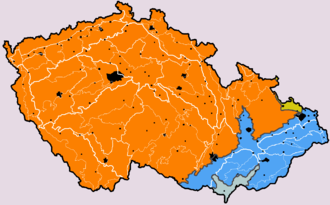Bohemian Massif


The Bohemian Massif (Czech: Česká vysočina or Český masiv, German: Böhmische Masse or Böhmisches Massiv) is a geomorphological province in Central Europe. It is a large massif stretching over most of the Czech Republic, eastern Germany, southern Poland and northern Austria.
The massif encompasses a number of
Parts of the
Geomorphological divisions

The Bohemian Massif is a province within the Hercynian Forest subsystem. It borders with four provinces: Western Carpathians on the east, Eastern Alps on the south, North European Plain on the north, and Central Uplands on the west. The Bohemian Massif is further divided into six subprovinces:[2]
- Sudetes; includes among others mountain ranges of Lusatian Mountains, Jizera Mountains, Giant Mountains, Owl Mountains, Stołowe Mountains, Hrubý Jeseník
- Ore Mountains; includes mountain ranges of Ore Mountains, Elbe Sandstone Mountains and Central Bohemian Upland
- Bohemian Forest; includes mountain ranges of Bohemian Forest, Bavarian Forest, Upper Palatine Forest, Gratzen Mountains and the Granite and Gneiss Plateau
- Bohemian-Moravian; includes Bohemian-Moravian Highlands and Brno Highlands
- Poberoun; includes the Brdy mountain range and the Prague Plateau
- Bohemian Table; includes the lowlands around the Elbe River
Geography
The
As in the other Variscan mittelgebirges of Central Europe, the valleys are more irregular and less pronounced as in the relatively young
.Geology
Tectonic subdivision
The internal tectonic structure of the Bohemian Massif was formed during the
The basement rocks and terranes of the Bohemian Massif are tectonically part of three main structural zones, which differ in metamorphic degrees, lithologies and tectonic styles. This tectonic subdivision was formed during the Variscan Orogeny.[4]
- The Laurussia.[5]
- The microcontinent.
- The southeast of the massif forms a third unit, the Moravian-Silesian Zone. This zone includes the Brunovistulian Block, an allochthonous unit thrusted over the Moravo-Silesian crystalline rocks. Contradictionary to most parts of the Bohemian Massif, the Brunovistulian was originally part of or close to the southern part of Laurussia.[6]
Resources
Unlike other Variscan massifs in Central Europe the Bohemian Massif is not very rich in
References
- ^ Migoń, Piort (2008). "High-mountain elements in the geomorphology of the Sudetes, Bohemian Massif, and their significance". Geographia Polonica. 81 (1): 101–116.
- ISBN 80-86064-99-9.
- ^ Linnemann et al. (2008b)
- ^ A subdivision into Saxothuringian and Moldanubian zones was first introduced by Kossmat (1927). The usual subdivision described here can for example be found in Linnemann et al. (2008a)
- ^ Linnemann et al. (2007)
- ^ Finger et al. (2000) linked the Brunovistulian terrane with "Avalonia" (i.e. the southern part of Laurussia)
Further reading
- Finger, F.; Hanžl, P., Pin, C.; von Quadt, A. & Steyrer, H.P.; 2000: The Brunovistulian: Avalonian Precambrian sequence at the eastern Bohemian Massif: speculations on palinsplastic reconstruction, in: Franke, W.; Haak, V.; Oncken, O. & Tanner, D. (eds.): Orogenic Processes: Quantification and Modelling in the Variscan Belt, Geological Society of London Special Publication 179, pp 103–113.
- Kossmat, F.; 1927: Gliederung des varistischen Gebirgsbaues, Abhandlungen des Sächsischen Geologischen Landesamtes 1, pp. 1–39.
- Linnemann, U.; Romer, R.L.; Pin, C.; Aleksandrowski, P.; Buła, Z.; Geisler, T.; Kachlik, V.; Krzemińska, E.; Mazur, S.;ISBN 1-86239-246-3.
- Linnemann, U.; D'Lemos, R.; Dorst, K.; Jeffries, T.; Gerdes, A.; Romer, R.L.; Samson, S.D. & Strachan, R.A.; 2008b: Chapter 3: Cadomian tectonics, in: McCann, T. (ed.): The Geology of Central Europe, ISBN 1-86239-246-3.
- Linnemann, U.; Gerdes, A.; Drost, K. & Buschmann, B.; 2007: The Continuum between Cadomian orogenesis and opening of the Rheic Ocean: Constraints from LA-ICP-MS U-Pb Zircon dating and analysis of plate tectonic setting (Saxo-Thuringian Zone, northeastern Bohemian Massif, Germany, in: Linnemann, U.; Nance, R.D.; Kraft, P. & Zulauf, G. (eds.): The evolution of the Rheic Ocean, from Avalonian-Cadomian Active Margin to Alleghenian-Variscan Collision, Geological Society of America Special Paper 423, pp 61–96.
